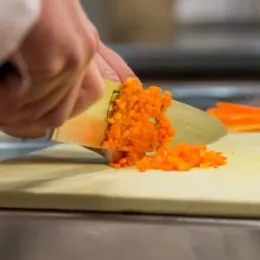Written by: Mark Duesler, Chef Consultant for the Food Service Technology Center
My name is Mark Duesler. I am the Chef Consultant for the Food Service Technology Center (FSTC), a resource for foodservice professionals. In California, we have programs set up specifically for energy efficiency in the foodservice sector and for good reason: refrigerating, cooking, holding, and serving food is incredibly energy intensive! On average, foodservice facilities use 5-to-10 times more energy than other commercial businesses.
To give you a better idea of this disparity, in 16 hours, a small fast food restaurant uses about the same amount of energy as a Home Depot or other big box store would in 24 hours. And with so many restaurants, it is important to consider energy use not only from a business perspective, but from an environmental approach as well.
From rebate incentives for energy-efficient equipment to invaluable design consultations and equipment demonstration programs, the FSTC offers many programs to culinarians as they grow and learn about their craft. We’ve collected several ways to curb energy use in foodservice operations from instituting best practices among staff to avoiding common pitfalls leading to unnecessary consumption. Check them out below!
Best Practices
- Fix Water Leaks– While they may seem small, that constant drip adds up.
- Replace Worn Refrigerator Gaskets– Refrigeration is always running. If the door gaskets are worn, a cooler or freezer is working harder than necessary, it is sucking energy and shortening its life. From experience, walk-ins always seem to go down at the end of service on a Saturday night (and that is no fun).
- On/Off Schedules– Most modern equipment only needs about 15 minutes to preheat. If it doesn’t need to be on, then shut it down. This practice also keeps the space more comfortable.
- Purchase Rebate Qualified Equipment– Rebate-qualified equipment has been designed/tested to be more efficient. This often means that the equipment performs better as well. Lost revenue to utility bills can be much more costly in the long run than the initial up-front cost of purchase.
- Energy Audits– A free service provided by the FSTC (for PG&E customers). We can come out and identify where the best energy efficient opportunities are in your kitchen.
Common Pitfalls
- “All equipment is the same”– These tools are the backbone of any operation. Not taking the time to examine the various energy pits in your operation ends up costing more money and precious time.
- Not Cleaning Condenser Coils– If you don’t clean the refrigerator’s coils, it is being starved of much needed air to cool the unit. This can also lead to a short life span and increased energy usage.
- Complacency– Ask questions and keep asking. There are a lot of resources out there to help you. Restaurants are constantly evolving with many moving targets, so the answer today may not be the same answer tomorrow.
Did you know you can try out the most advanced appliances without committing to a purchase? At the FSTC, we have an inventory of high-end demonstration equipment such as combination ovens, high-speed ovens, pressure fryers, vacuum sealers, and immersion circulators. These pieces of equipment are available for you to test your recipes and hone your skills. As a cook, it is a terrific way to expand your knowledge as you further your career. It’s an opportunity to learn what tools and technologies are available, which can help you gain an advantage in the particularly competitive culinary world.
This blog post was originally published by the International Culinary Center (ICC), founded as The French Culinary Institute (FCI). In 2020, ICE and ICC came together on one strong and dynamic national platform at ICE's campuses in New York City and Los Angeles. Explore your culinary education where the legacy lives on.



